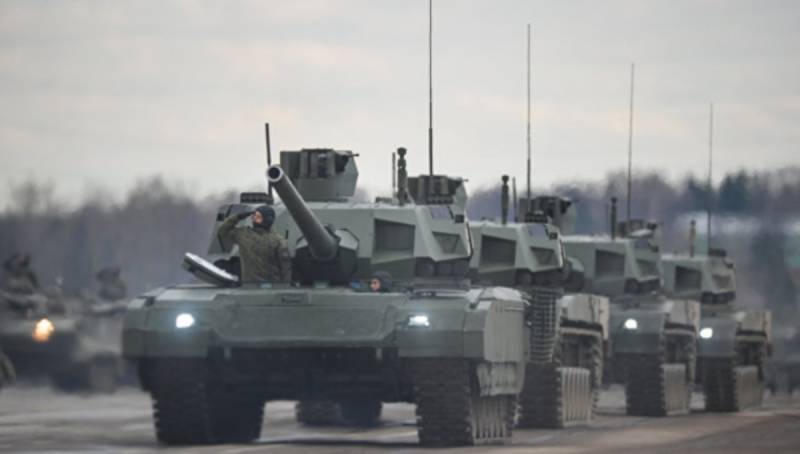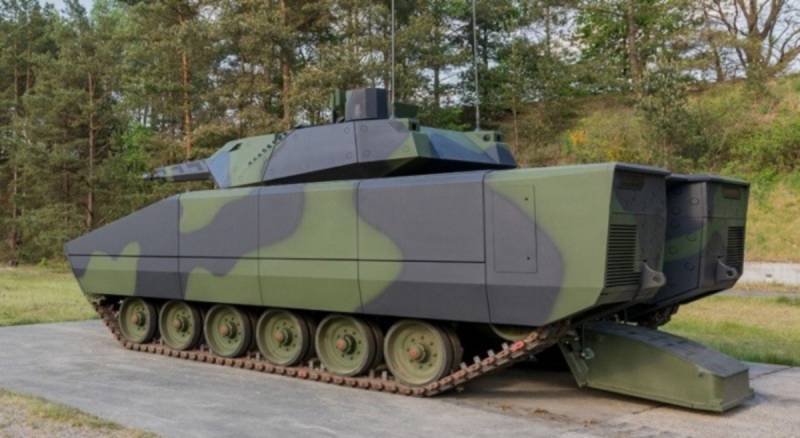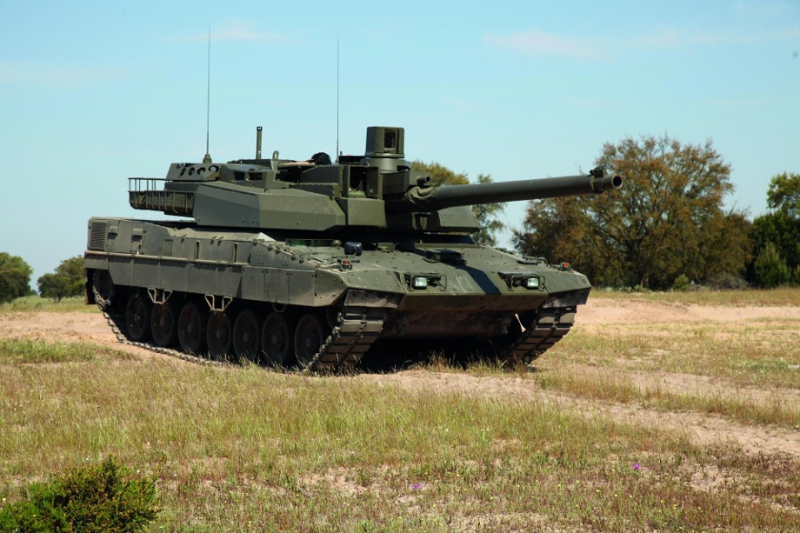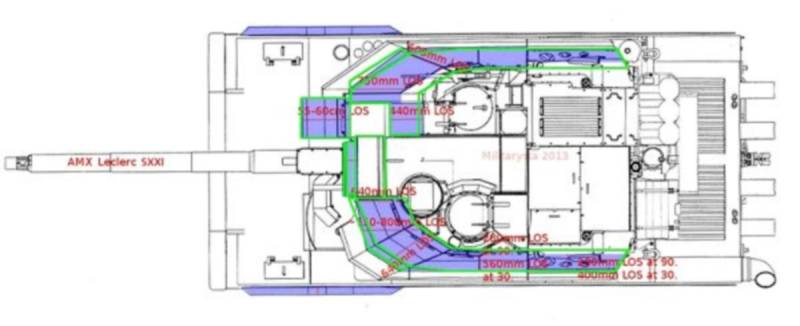The first fruits of the chase for "Armata": what the enemy is trying to overcome the T-14 and T-15
Two concepts presented during the 26th Eurosatory-2018 International Exhibition of Arms, Security Technologies and Means of Defense, which took place in Paris from June 11 to 15, can cause keen interest among fans of military equipment and specialists. We are talking about the heavy German next-generation heavy infantry fighting vehicle “Lynx KF41”, as well as a very controversial Franco-German product - the advanced “network-centric” main combat tank EMBT "European Main Battle Tank". Both combat vehicles, like most types of armored vehicles for participating in network-centric wars of the XNUMXst century, are equipped with modern terminals for exchanging tactical information on secure radio communication channels, as well as means for displaying it, coupled with high-performance combat information-control systems.
Therefore, it is logical to assume that in the defense departments and armies of the leading NATO member states they can be viewed as a “strategic asset” of the ground forces in the European theater of operations in opposition to our line of combat vehicles on the Armat’s universal tracked platform. But, as you know, only one network-centric e-stuffing on the battlefield of the third millennium will not go far, and therefore it is very useful to consider, or at least evaluate (starting from photographs and videos on which the first demonstrators are captured) the level of security and weaponry these samples. We begin, of course, with a heavy infantry fighting vehicle "Lynx KF41".
The first version of the concept of this BMP (“Lynx KF31”) was presented to the public even 14 June 2016 of the year, as part of the 24-th exhibition “Eurostary-2016”. Then a car appeared in front of us with thin (almost “paper”) sheet anti-cumulative screens, which in the literal sense of the word will turn into a “sieve” after the very first shelling of large-caliber small arms, not to mention the line-up from ZU-23-2 or “ Shilki. The corps of the first version of the “Lynx” was nothing more than a constructive analogue of the corps of the obsolete heavy infantry fighting vehicle “Marder-1A3” with all the ensuing consequences, - the protection of the frontal armor plate of the corps (with the angle of inclination of 75 degrees to the normal) only from the armor piercing subaliber 30x165 mm shells (at a distance ≥ 400 m; we are talking about Kerner ZUBR8 and NATO armor-piercing fired PMC303 tracer, capable of piercing 400- and 80-mm steel armored plate at 100 mm through 0 and 80 steel barrels under the angle 100 and X-NHXXHXXXXXXXXXXXXXXXXXXXXXXXXXXXXXX-XXXXX-mm of X-968 equivalent resistance from the BOPS / BOPTS of this model, the Lynx BMP was approximately 14,5 — 41 mm. The onboard projections protected only from 32-mm projectiles of BS-40 and B-50 type, which have armor-piercing around 23 mm; is about 30 mm, but these indicators are absolutely not enough to protect frontal projection from larger-caliber armor-piercing shells and some types of hand-held anti-tank weapons, and onboard projections from XNUMX- and XNUMX-mm automatic guns.
As a result, the experts of the leading German brand-developer of armored vehicles and diesel engines Rheinmetall decided to move away from using the design of the Marder family of infantry fighting vehicles as a base for a new-generation vehicle and fixed their eyes in the direction of the new Puma infantry fighting vehicles, which are capable of endure shelling 45 — 50-mm armor-piercing feathered sub-caliber shells, penetration of which can reach 200 — 220 mm steel equivalent at an angle 0 degrees to the normal at a distance more than 1000 m. Consequently, the thickness on VFD "PUMA" excluding 75-degree tilt armor plating can be 55 mm; Airborne armor plates of the hull (especially in the front part) can even protect against 30-mm armor-piercing projectiles even at maximum maneuvering angles of +/- 45 — 50 degrees, which is achieved by using massive modular booking elements placed on anti-cumulative grilles.
Based on the experience gained during the design of the Puma BMP, which is now being used by the Bundeswehr, the specialists of Rheinmetall AG made the final version of the Lynx KF41 even more armor-proof. Based on the photographs of the exhibition, as well as the first video presentations on which Lynx’s test sites are captured, you can pay attention to many structural details that give an estimated idea of the equivalent durability of various projections of an infantry fighting vehicle. In particular, on the massive upper frontal details, you can see the contours of the elements of modular booking, as well as the hatch of the driver. The hatch is located not in the middle of the BWD, as in the “Marder-1A3”, but in the area of the tower shoulder strap, at the maximum distance from the “wedge-shaped” joint of frontal parts (WLD and NLD). You can also pay attention to the contours of a rectangular cell around the hatch of a mechanized drive, which, obviously, denote the boundaries of its “armored capsule”; they are located at a distance of more than 1 m from the interface of the ILD and NLD.
This design may indicate that the equivalent durability of the upper frontal part of a new BMP from armor-piercing feathered sub-caliber shells may exceed the performance of the BMP Puma (200 — 220 mm) and reach 300 — 350 mm, and the 1140 engine, hp from Liebherr, it has noticeably larger dimensions, which requires much more internal space than the 600-strong 6-cylinder diesel Daimler-Benz MB833. Therefore, it can be argued with high probability that the frontal projection of the hull can be protected not only by 30-mm APFSDS-T type NM 225 projectiles with 120 mm armor penetration at 1000 m and 40-mm BPS APFSDS-T Mk 2, developed by specialists company «Bofors Defence» to 40-mm automatic guns L / 70B and CT40 with penetration of about 200 mm at a distance of up to 1 km, but also from the old 125-mm armor-piercing feathered projectiles types of MBA-15 and MBA-17 with armor penetration 340 and 330 mm, respectively.
The onboard projections of the Lynx KF41 perspective infantry fighting vehicle corps are covered with massive passive protection modules with a physical dimension from 100 mm (in the lower part) to 150 mm (in the upper part, near the roof of the building). The modules are represented by built-in multi-layer special booking packages, the structure of which, for obvious reasons, is not made public. It is most likely that layers of “cellular” composite ceramics are used, the matrix of which is reinforced with silicon carbide and aluminum oxide to reduce brittleness and preserve the same strength characteristics typical of standard homogeneous steel armored plates. Layers based on polyurethane and other composite materials can also be used.
Such a structure of reserving can significantly ease the mass of an armored vehicle unit while maintaining the same level of security, the British division of Lockheed Martin UK, which is promoting its achievements in the European armament market, is currently working on developing such materials. The design of armor-packages of the attack helicopter Mi-28H, represented by 10-mm aluminum sheets with 15-mm ceramic blocks glued to them, points to the excellent prospects for such a booking. Therefore, we have an 26-mm aluminum-ceramic armor “cake” with 1,65 times smaller than that of a steel plate, but having similar parameters of equivalent durability. All this applies to the German BMP "Links KF41", which is why the developer indicated the stock of accumulative mass in 6000 kg.
The above-mentioned modular armored plates, also playing the role of protivokumulyatnyh screens (PKE), together with the onboard body armor plates form an armored barrier with dimensions from 120 to 170 mm mm with a half-meter air gap. Consequently, the hull board without any problems withstands hitting our 30-mm armor-piercing projectiles ZUBR8 "Kerner" at an angle of meeting 0 degrees to the normal from minimum distances (200 — 300 meters) and 40-mm APFSDS-T Mk 2 at safe maneuvering angles ± 50 degrees from the course direction of the machine with similar ranges of fire. When firing with safe maneuvering angles of ± 20 — 30 degrees, the Lynx KF41 board can withstand the hit of 125-mm “Pin” or “Nadezhda-R” armor-piercing projectiles or anti-tank grenades PG-9BC of the SGGNUMNUMNUMNUMNTMGNUMNUMNTMGNUMNUME -GUMNUMT-9NUMNUM-T.G. large meeting angles).
Naturally, there is a way to break through the Lynx side armor using the KND 12,7-mm machine gun: for this you need to fire the bare armor plate in a narrow strip under the on-board protection modules (between the support rollers), but this is possible only from the minimum distances a few hundred meters, plus when the “KF41” will be located on a certain elevation of the terrain, somewhat higher than the machine-gun crew. Otherwise, this sector will be covered by the “terrain screen”. Taking into account the increase in mass of the new German BMP to 50 tons, in the future, the car can be equipped with a complex of tandem DZ, which will allow to act on the most difficult parts of the theater of operations with high fire impact from the enemy by such means as "boots", RPG-7BP, and in some cases, the Konkurs-M ATGM system.
Special attention should be paid to the measures for protecting the airborne unit in the area of the aft ramp. Here, the specialists of Rheinmetall AG, obviously, paid attention to the entry / exit unit of the heavy Israeli tracked armored carrier “Namer” and the Russian advanced heavy infantry fighting vehicle T-15 “Armata”. Firstly, the Lynx KF41 access hatch is recessed into the rear part approximately 1 m. This design virtually eliminates fragmentation-high explosive shells and other damaging elements of the enemy from direct contact at angles of ± 60 — 70 degrees from the longitudinal axis of the body machines, that is, from the side angles shifted into the rear hemisphere. A projectile may get into the troop compartment with an open ramp only possible by cutting the U-shaped amphibious unit from the armored blocks, in which the engine cooling system circuit is also integrated; but for this, the enemy will need to get to the tank’s rear zone with a floor angle of about 40 degrees from the longitudinal axis of the BMP, which in combat conditions (during the landing) is not an easy task.
As for the closed ramp, here the developer still took into account the likelihood of shelling from large-caliber automatic guns BTR and BMP, as well as some hand-held anti-tank weapons, because maneuvering during combat, as well as leaving the battlefield provide for the complete exposure of the stern projection for the opponent. In one of the photos of the demonstrator, you can note that the thickness of the hatch ramp is much greater than that of Kurgants-25 and even Namer: its size in the lower part is 45 — 50 cm, in the top — 250 mm, which indicates providing protection against 40 — 45-mm armor-piercing shells, as well as the above-described tank 125-mm armor-piercing shells in the lower sector.
Assessing the armor-proofness of the welded turret “Lynx KF41”, it is necessary to take into account that it is habitable and has a decent reserved volume in which the vehicle commander and gunner are placed, as well as part of the ammunition load. If you watch the video demonstration provided on “YouTube” by the “Rheinmetall Defense” division, you can pay attention to the episode of the car’s passage on a dirt country road, taken from a copter. Here you can clearly see the depth of the hatches of the crew, which reaches 1,5 m. We subtract from this another 700 — 800 mm covering the control compartment in front of the hatches, and we have 300 — 350-mm steel or aluminum frontal armor plate and wedge-shaped modular packages special booking of the same size, which ultimately provides equivalent durability of the order of 500 — 700 mm (depending on the type of special booking and mechanical properties of the used composites and metals); this almost corresponds to the level of protection of the early modification of the Leopard-2A4 MBT, which is an excellent indicator for an infantry fighting vehicle.
The weakened zone in the side projection of the turret is standard - the embrasure sector of the main gun, to compensate for which, the developer equipped the gun with a massive multi-faceted “mask”, which significantly increases equivalent durability. The “mask” of the gun smoothly passes into the heat and radio absorbing “cover”, the inside of which has a contour for running distilled water or antifreeze, and some external elements are radio absorbing materials that significantly reduce the radar signature of the BMP “Lynx KF41” along with the radio absorbing coverings of the modular booking the entire corps of a combat vehicle. This concept of reducing infrared and radar visibility "Lynx KF41" fully complies with next-generation standards, the detection range of which is using X-band radar reconnaissance aerial tools, as well as portable radar reconnaissance of ground positions and target designation of artillery of the type "Xenum 1" and " Farah-1PV "should be kept to a minimum. In favor of this concept is played not only by the “mask” of the gun, but also by the design features of the location of the missile armament of the new German BMP.
In particular, the twin-module modular launcher of the Israeli anti-tank complex Spike-LR2 is not attached to the left-side armor plate of the turret (in a vertically oriented launch module, as in the early modification of the Lynx KF31), but hidden in a specialized on-board niche of the tower and extends into the platform adjustable by hydraulic drive in elevation plane. This prevents the disabling of combat-ready anti-tank missiles and damage to transport-launch containers in the event of shelling from enemy large-caliber machine guns and automatic guns BMP, also significantly reduced EPR and optical visibility "Lynx" in the frontal projection. Developed by Rafael to 29 in May 2017, the long-range Spike-LR II (Long Range II, or Gil-2) anti-tank missile belonging to the 5 generation anti-tank weapon received an advanced radio channel control system communication (instead of communication via fiber optic cable), which allows it to be used in the most difficult terrain areas.
The missile is capable of striking a powerful tandem cumulative warhead in the most weakened upper armor plates of the enemy’s unit tower, which leaves no chance if there are no active defense and optical-electronic countermeasures as part of the enemy’s mechanized unit. In addition to an infrared photo detector with a 3 generation matrix, the optoelectronic homing head also has a TV sensor that operates in 720p resolution; As a result, to repel an impact, a smoke screen should be installed, infrared traps should be used, as well as exposure to laser and high-frequency electromagnetic radiation. Meanwhile, for accurate direction finding of the flying Spike-LR2 anti-tank guided missile, with subsequent impact on it by the above means, it is necessary to have all infrared stations that detect missiles by thermal radiation from rocket engines or centimeter / millimeter radar systems. "Spike-LR2", having a range of 5500 m, is able to penetrate up to 900 mm steel equivalent for DZ "Contact-1".
The main means of defeating the “Lynx” is a 35-mm automatic “Wotan” cannon, dressed in a “case” (we talked about it above), integrated into the turret - the Rheinmetall Lance 2.0 combat module. What is known about this gun? In fact, this gun is a conceptual and constructive continuation of the 35 mm Oerlikon KDG Swiss gun, the production license of which passed into the hands of Rheinmetall AG in the early 2000s. (after the takeover of Oerlikon by German weapons concern). This cannon can be found in numerous ground and naval defensive platforms of European design, mainly as anti-aircraft guns. For example, as part of the MANTIS and Skyshield anti-aircraft artillery defense systems (6 and 12 BM Oerlikon-Rheinmetall KDG cannons each are capable of targeting mortar shells, UAVs, etc., by target designation from a continuous radar system and OLPC) as part of the ship-based Zaklak Oerlikon Millennium, or anti-aircraft self-propelled guns Skyranger.
The ballistic qualities of this weapon are quite impressive and coincide with the ATK Bushmaster III cannon: the initial speed of the 35xXNNXX sifting armor-piercing projectile PMD 288 (APFSDS-T family) is 060 m / s, so that at a distance of 1440 km the unit can be hit the enemy, which is represented by an armor plate thickness of 2 mm at an angle of 50 degrees and around 60 mm at an angle of 90 degrees to the normal. Neither the BMP-0, nor BMP-1000, nor the Kurganets-1500 will be able to withstand the hitting of such projectiles at the distance 2 — 3 meters at the distance of 25 — 15 meters. The only "panacea" in the confrontation with the "Lynx" can be anti-tank calculations, armed with the "Cornet", heavy combat vehicles T-72 "Armata", as well as BMPT-41 "Terminator", able to withstand shelling from "Oerlikon". The driving performance of the Lynx KF44 BMP, although it does not involve forcing deep water obstacles due to the huge tank mass in 50 and 22,8 tons after completing the dynamic protection system, as well as the active optical-electronic counter-response complex of MUSS and active protection AMAP-ADS, allow you to achieve power density in 26 — XNUMX hp / t, which, in combination with the MTO from Renk AG, provides excellent progress over rough terrain.
In the final part of our review we will take a brief look at another interesting concept from the Eurosatory-2018 exhibition - the main battle tank EMBT European Main Battle Tank, developed by the French-German industrial group KNDS, formed by the merger of the German Krauss-Maffei Wegmann and the French NEXTER Defense System. The machine is a hybrid of the French AMX-56 "Leclerc" (it borrowed a tower and a smooth-bore gun) and the German "Leopard-2A7" (this machine became a "donor" of the hull and the engine compartment). Here we can state the only thing: the design and creation of the demonstrator took just three years after the merging of KMW and Nexter, which means that the implementation of the EMBT program was carried out in a hurry, as a kind of “fast” asymmetrical response to the announcement of the promising MBT in 2015 year T-14 "Armata" ("Object 148"), because the development of the project of the advanced French-German MBT with the 130-mm cannon "Main Ground Combat System" (MGCS) is only in its infancy, and completion is planned only by the beginning of 30-x yo But was the "game" worth the candle with the creation of a new "armored demonstrator" on an existing base? From the point of view of the evolution of network-centric theaters of war, it is quite possible, since the Leclerc tower has long been considered the most promising information cocoon not only among the tank parks of European NATO member countries, but also against the background of the armed forces of other nations of the world.
For example, today “Leclercs” plan to equip the SICS with the most advanced tank information control system (TIUS), which will integrate a high-performance fire control system (SLA), as well as duplicate commander and gunner terminals for exchanging tactical information with other tank crews , or any other units of equipment of friendly units that are equipped with similar data transfer stations. The basis in this case is the standard combined multiplex data bus MIL-STD-1553B. The SICS system should replace the aging SIT ICONE IIS, which is at the disposal of the commander of the Leclerc Block III. As the main armament of the promising EMBT tank, the KNDS group retains the “Leclerk” 120-mm smoothbore gun CN120-26 with a length of 52 caliber, providing the initial BOPS speed in 1750, which corresponds to the level of the German Rh120-L55. This is quite enough to give maximum armor penetration by standard French OFPS 120 F2 type BON at the 650 level - 700 mm, or more using DM63A1. But not in the gun the whole thing.
The armor protection of the Leclerc tower remains at an extremely mediocre level even in comparison with the Leopard-2A7, not to mention the T-90C, M1A2 SEP or Challenger 2. This is confirmed as a renowned information-analytical /historical resource “Tank power. Steel and fire ”(btvt.narod.ru), as well as drawings of sections of the Leclerka tower found on Western resources. So, official sources speak of the equivalent resistance of the frontal armor plate of a tower within 650–700 mm from armor-piercing feathered sub-caliber shells and 1150–1200 mm from a CS: reliable protection is provided only from BPS BMS-42M Lekalo and ZBM-46 Lead. This is confirmed by the drawing with measurements of the frontal and side dimensions. As for shelling the side projections of the tower at an angle of 60 degrees, their equivalent resistance reaches only 560 mm (protection is provided only from obsolete 125-mm armor-piercing shells "Nadfil-2" and "Mango").
Leopard-2A7, equipped with massive overlays of modular booking, has a frontal projection resistance of 850 mm and beats (at safe maneuvering angles ± 30 degrees) about 650 — 670 mm, which is much better than Leclerc. Conclusion: the EMBT project is unprofitable for the German side (a good chassis of the Leopard receives the weakly protected Leclerc tower, while KMW could independently raise the network-centric qualities of the Leopard through proper digitization of the previous tower); for the French ground forces, the project will not bring any advantages in terms of survivability on the battlefield. And therefore, the hybrid tank EMBT a priori cannot be considered as a serious contender for our T-14 "Armata".
Information sources:
https://tvzvezda.ru/news/vstrane_i_mire/content/201806120829-zy6n.htm
http://fofanov.armor.kiev.ua/Tanks/ARM/apfsds/ammo_r.html
http://btvt.narod.ru/4/boepripas_20_30.htm
http://www.airwar.ru/weapon/guns/35-1000.html




Information